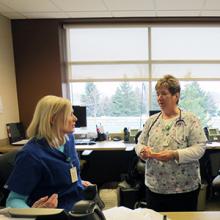What is a Naysayer Practice?
A Naysayer Practice has a single, influential member of the team who does not believe any improvement can occur or is a saboteur of an improvement effort. All other clinic team members may be actively and happily engaged with an improvement effort, but the naysayer prevents the clinic from making significant positive changes.
Example from a practice facilitator:
This Naysayer Practice was based in a rural area and had two staff and three clinical providers. Early on in my engagement, one of the two clinicians who attended team meetings was very negative about improvement efforts. She did not believe in the clinical guidelines that I shared, and aggressively accosted me before each meeting about the intent of the project. Additionally, she openly disagreed with her team members about the clinic’s workflows and quality improvement processes. Eventually, this individual left the clinic, and the team was able to finish the project strongly!
Data
The practice can generate data, but one or more members do not trust that it is correct and therefore discount it.
Although the practice can run queries and generate data reports, they often do not have a full understanding of where the data originates and that causes staff to question whether the data are current or accurate. Additionally, an individual clinician may believe, with or without justification, that the data are wrong for their patient panel. They may believe the data generated underrepresent their actual performance, because of incorrect data definitions or inaccurate data capture.
Strategies
A QI culture depends on the staff trusting that the data are correct. Practice facilitators should start by explaining how the data are generated for the reports that the practice runs and work with practice staff to find clinical measures that are not only timely enough to be actionable, but also the most relevant for their population. Often the practice has had prior experience with reports they found to be incorrect, so they may need to be walked through data summaries to build familiarity and trust in the data. Suggest that a clinical staff member look up a sample of 10 to 20 patients and verify accuracy of information. By teaching practice staff how to validate their data, you can decrease anxiety around reporting and empower staff to look at their data in a meaningful way. Finally, encourage one member of the team to become a “power user” – a local resource for the team who spends some time building expertise and comfort with the practice’s systems. Ideally, this team member can include this work as a part of their job description.
The practice successfully generates data but does not know how to use it to drive improvement.
This practice may already look at data reports regularly or have dashboards for their clinicians. Because they have access to data and share it internally, they may feel like they are doing everything they can/need to do. In some cases, they might receive support from an external agency for generating reports or gap lists, but they do not have a framework in place to act on those reports. They may not be using benchmarks, goals, or comparisons to national benchmarks to drive improvement.
Strategies
The practice facilitator can identify measures of care that reflect a shared priority among the staff and start a conversation about what actionable steps might be taken in areas where they want to improve. Start small and help them set attainable goals. Focus on aspects of quality improvement from their daily activities, as it is easier to identify how the data can be used to drive improvement. Once they have success at not only generating, but also interpreting reports, help them build up to larger population-scale tests. Using data visualization tools like The Pulse or simple run charts with agreed upon goal lines can be an effective way to engage staff and tie efforts to data trends. For data capture issues and EHR optimization, initiate a redesign session with a staff member representing each part of the workflow. The staff members can identify the current process for data capture and design the improved process while referencing the EHR user guide. The user guide will help them understand the EHR’s capabilities to ensure all care steps are being performed and that corresponding data capture is being done correctly. Finally, educate the team on the Model For Improvement (MFI) and Plan-Do-Study-Act (PDSA) cycle framework to guide improvement work. Demonstrate this quick powerful tool for accelerating improvement by helping the team complete a PDSA form and get them set up to run their first test of change. Testing the new workflow for optimal data capture can be a good way to apply a PDSA cycle to an active project and determine if the change is an improvement that can be adapted, adopted, or abandoned.
QI Team and Project Management
The practice lacks a systematic way of identifying issues quickly or anticipating bottlenecks, and instead treats problems on a case-by-case basis as they erupt.
This practice addresses issues as they arise rather than establishing systems to monitor activities to quickly identify and address inefficiencies or prevent emerging issues before they arise. The practice team may identify issues and create ideas on how to solve these issues, but it is often ad-hoc and unsustainable. After a problem is addressed and the crisis passed, there is no opportunity to learn from the situation or apply solutions to other areas proactively.
Strategies
A practice facilitator can start by teaching this practice why they should monitor the progress of changes over time. Encourage the team to involve all team members that impact a process so that causes are well understood and unintended consequences from the changes are avoided or mitigated. Help them to sustain the change and to not go back to the old workflow after they stop giving it their focus. Use their example of a past quality improvement project as a way to get buy-in from practice staff since it is an example they can directly relate to. Explain that follow-up on these improvements does not have to be intrusive or overbearing. Help them create a mechanism for quality assurance and for follow-up on identified issues that can be applied uniformly across the entire staff and that does not single people out in a negative way. Basing performance off measurable data points is a great way to do this, because there is a shared framework that can be used to define success and monitor counter measures (Steven’s “Supporting people to quit smoking can have an enormous, lasting impact from” H2N blog). Using the PDSA worksheet in conjunction with encouraging the practice to view its own data can be an effective tool with this practice.
Culture
The practice has an aversion to change, so new solutions are hard to implement.
This practice might say things like “We have been doing this for years” or “We already have a workflow in place for that issue.” They may have addressed the problem in the past but lack a structure to ensure they follow up on their work or move on to new goals or approaches. Reluctance by this practice to discuss new ways of working may be tied to their belief that they are already performing quite well, despite indications in their data that there are areas for improvement. In some cases, this overconfident practice can become “straightjacketed” by a need to achieve perfection—only willing to take on new tasks if they can immediately perform them well, and therefore they may be averse to small-scale tests of change.
Strategies
Practice facilitators can run clinical quality measure reports for this practice comparing their performance data against other similar practice data or benchmark data, which can uncover opportunities for improvement. After addressing concerns they have with comparability of the practice or quality of the data, invite them to consider a small test of change, beginning with a simple workflow mapping exercise. After an initial success, people will be more willing to explore new ways. It may also be helpful to expand the number of staff engaged in a topic to get more buy-in. Some practices have used structured trainings followed by staff satisfaction and learning surveys to boost engagement successfully. Overconfidence may occasionally be a coping mechanism for teams reluctant to spend the time or energy examining their processes. Data performance can convince an overconfident practice to establish a quality improvement team and incorporate some of the facilitation strategies.
Data
148QI Team and Project Management
149Culture
152If you have a question about the improvements, action steps, or tools & resources in this module please let us know. We're here to help. And if we can't answer your question, we can probably connect you with someone who can.




